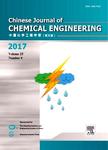Assessing the kinetic model of hydro-distillation and chemical composition ofAquilaria malaccensis leaves essential oil
Assessing the kinetic model of hydro-distillation and chemical composition of Aquilaria malaccensis leaves essential oil作者机构:Department of Chemical and Environmental EngineeringFaculty of EngineeringUniversity Putra MalaysiaserdangSelangorDaml Ehsan 43400Malaysia Aerospace Manufacturing Research Centre(AMRC)Level 7Tower BlockFaculty of EngineeringUniversity Putra Malaysia43400 5erdang SelangorMalaysia Forest Research Institute Malaysia52109 Kepong5elangorDarul EhsanMalaysia
出 版 物:《Chinese Journal of Chemical Engineering》 (中国化学工程学报(英文版))
年 卷 期:2017年第25卷第2期
页 面:216-222页
核心收录:
学科分类:0710[理学-生物学] 090403[农学-农药学(可授农学、理学学位)] 0830[工学-环境科学与工程(可授工学、理学、农学学位)] 0817[工学-化学工程与技术] 09[农学] 0904[农学-植物保护] 0703[理学-化学]
主 题:Aquilaria malaccensisEssential oilHydro distillationOptimizationKinetic modeling
摘 要:This study aimed to model the kinetic of hydro-distillation of Aquilaria malaccensis leaves oil in order to understand and optimize the extraction process. In addition, this study, for the first time, aimed to identify the chemical compositions of the A. rnalaccensis leave-oil. By assessing both first-order kinetic model and the model of simultaneous washing and diffusion, the result indicated that the model of simultaneous washing and diffusion better describes the hydro-distillation mechanism of the essential oil from A. rnalaccensis leaves. The optimum time, solid to liquid ratio, and the heating power for extracting the highest amount of essential oil were found to be around 3 h, 1:10 (g. ml-1), and 300 W respectively. Yellow essential oil with a strong smell and a yield of 0.05 v/w was extracted by hydro-distillation Clevenger apparatus. Chemical compounds of the essential oil were analyzed using gas chromatography-mass spectroscopy (GC/MS), which resulted in identification of 42 compounds that constitute 93% of essential oil. Among the identified components, Pentadecanal (32.082%), 9-Octadecenal, (Z) (15.894%), and Tetradecanal (6.927%) were the major compounds. Considering the fact that all the identified major components possess pesticidal properties, A. malaccensis leaves can be regarded as a promising natural source for producing pesticides.



